Jeremy Swan, internationally famous cardiologist and committed member of the American Ireland Fund, has died in Los Angeles aged 82.
Born in 1922 in Sligo, the son of two family practitioners, Harold Swan and Marcella Kelly, he was christened Harold James Charles Swan but was known since childhood as Jeremy. Throughout his life he retained very pleasant memories of Sligo. He had visited some of the great houses such as Lissadell with his father on house calls, and had met W.B. Yeats at Drumcliffe rectory when his father treated the ailing poet.
Swan was educated initially at Kilashee preparatory school near Naas, before moving to Glenstal Abbey and then St Vincent's College, Castleknock. He was accepted to study medicine at Trinity College Dublin but, when his parents' marriage ended in 1938 and his mother moved to London, he decided to study at St Thomas's Hospital.
After graduation in 1945 he worked there, and a year later both became a member of the Royal College of Physicians of London, an outstanding achievement at his age, and joined the Royal Air Force Medical Service, spending two years in Iraq.
On his father's death in 1948 he decided not to return to Sligo to the practice but to work as a research fellow at St Thomas's under the famous physiologist Henry Barcroft. For his PhD thesis he had the support of Sir Henry Dale, Nobel Prize winner in 1932. Swan's early publications on the human vascular system are now regarded as medical classics.
In 1951 Swan joined the staff of the Mayo Clinic in Rochester. There he made another major contribution to medicine when he developed ways to detect birth defects of the heart. In 1965 he was appointed professor of medicine at the University of California in Los Angeles (UCLA) and director of cardiology at Cedars-Sinai Medical Centre.
At that time little could be done for heart attack patients. Swan realised that a greater understanding of the problems associated with coronary thrombosis could be obtained if it were possible to measure pressures within the heart and the surrounding vessels.
To achieve this a very fine tube or catheter had to be introduced through a vein and manipulated using X-ray guidance into and through the heart chambers of very sick patients, a dangerous procedure.
Swan's solution came to him in 1967 while standing on the beach in Santa Monica. He noticed a boat about half a mile offshore with a large spinnaker well set and moving through the water at speed. It occurred to him to put a sail or some form of flotation device on the end of a highly flexible catheter which would be propelled rapidly and safely through the blood vessels and chambers of the heart.
Trials on animals, using a double-bore catheter with a small inflatable balloon at its apex, were successful, and Swan and a colleague, William Ganz, developed the device for use in patients. The Swan-Ganz catheter was soon in use in every coronary and intensive-care unit throughout the world. Swan's department developed an international reputation, and he influenced the careers of hundreds of cardiologists, many of them subsequently achieving fame in their own right.
He had a very demanding medical practice, and the boy who went on house calls with his father in Sligo now had the leaders of US society coming to consult him. He also began to present medical programmes on TV and became a familiar host nationwide.
Swan was president of the American College of Cardiology in 1973 and received many prestigious awards. He kept up his links with Ireland and was a strong supporter of the American Ireland Fund. He was elected to honorary fellowship of the Royal College of Physicians of Ireland in 1994, and was awarded an honorary doctorate of medicine by Trinity College.
He has been described as "the perfect blend of scientific cardiologist and compassionate physician."
He is survived by his wife, Roma, six children from his first marriage to Pamela - Caroline, Elizabeth, Geraldine, Eleanor, Jeremy and Gordon, 11 grandchildren and one great grandchild. He was predeceased by another daughter, Katherine, in 1992.
Jeremy Swan: born June 1st, 1922; died February 7th, 2005









